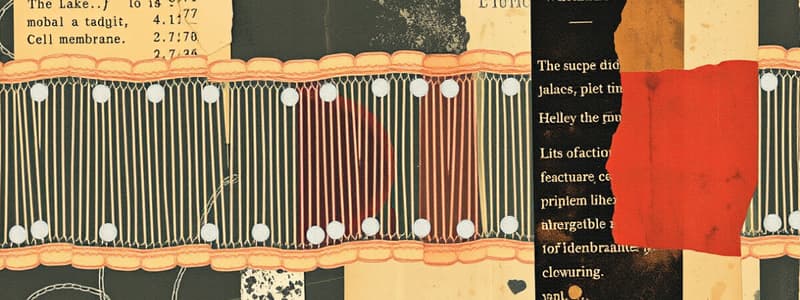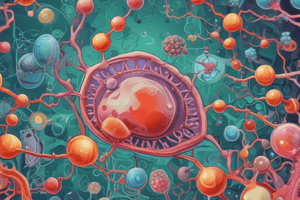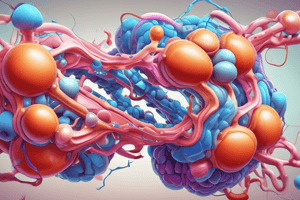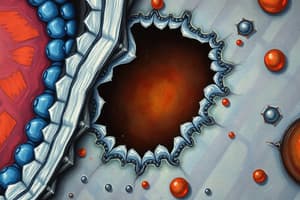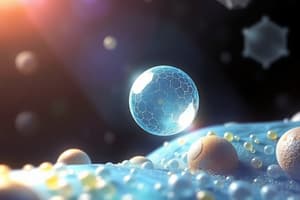Podcast
Questions and Answers
What is the primary structural feature of biological membranes in eukaryotic cells?
What is the primary structural feature of biological membranes in eukaryotic cells?
- They are formed by a protein-copolymer structure.
- They contain only cholesterol.
- They are bilayers of phospholipids. (correct)
- They are composed of a single lipid layer.
Which lipid type is particularly important for cell communication and membrane composition in animals?
Which lipid type is particularly important for cell communication and membrane composition in animals?
- Steroids (correct)
- Triglycerides
- Phospholipids
- Waxes
What role do waxes play in biological systems?
What role do waxes play in biological systems?
- They are components of the plasma membrane.
- They are essential for cell signaling.
- They protect against dehydration and contaminants. (correct)
- They are the primary energy storage form.
What is true about triglycerides in relation to biological membranes?
What is true about triglycerides in relation to biological membranes?
What is a common characteristic of steroid hormones?
What is a common characteristic of steroid hormones?
What characterizes phosphoglycerides in terms of their structure?
What characterizes phosphoglycerides in terms of their structure?
What type of lipid is classified as a sphingolipid?
What type of lipid is classified as a sphingolipid?
What is the primary difference between phospholipids and glycolipids?
What is the primary difference between phospholipids and glycolipids?
How do unsaturated fatty acids contribute to membrane fluidity?
How do unsaturated fatty acids contribute to membrane fluidity?
Why is cholesterol important in biological membranes?
Why is cholesterol important in biological membranes?
What role do polar heads play in phospholipids?
What role do polar heads play in phospholipids?
What characterizes the structure of cholesterol?
What characterizes the structure of cholesterol?
Why are triglycerides not classified as membrane lipids?
Why are triglycerides not classified as membrane lipids?
How do lipoproteins facilitate lipid transport in the body?
How do lipoproteins facilitate lipid transport in the body?
What determines whether a lipoprotein is classified as high density or low density?
What determines whether a lipoprotein is classified as high density or low density?
What is a significant health risk associated with excessive low-density lipoproteins (LDL)?
What is a significant health risk associated with excessive low-density lipoproteins (LDL)?
What is a characteristic of waxes in relation to their structure?
What is a characteristic of waxes in relation to their structure?
What role does the hydroxyl group play in the structure of cholesterol within the membrane?
What role does the hydroxyl group play in the structure of cholesterol within the membrane?
Where do triglycerides primarily accumulate in the body?
Where do triglycerides primarily accumulate in the body?
What is the primary role of scramblase in lipid distribution within the cell membrane?
What is the primary role of scramblase in lipid distribution within the cell membrane?
What change occurs in the phosphatidylserine distribution during apoptosis?
What change occurs in the phosphatidylserine distribution during apoptosis?
What does the dark appearance of the lipid bilayer in electron microscopy represent?
What does the dark appearance of the lipid bilayer in electron microscopy represent?
Which component is crucial for the differentiation between the apical and basolateral membranes in epithelial cells?
Which component is crucial for the differentiation between the apical and basolateral membranes in epithelial cells?
Why is asymmetry in the lipid bilayer considered functionally important?
Why is asymmetry in the lipid bilayer considered functionally important?
What role does glycosylation of lipids play in cellular communication?
What role does glycosylation of lipids play in cellular communication?
What is a characteristic feature of the internal mitochondrial membrane?
What is a characteristic feature of the internal mitochondrial membrane?
Which statement best describes the orientation of membranes created from the Golgi apparatus?
Which statement best describes the orientation of membranes created from the Golgi apparatus?
Where does the synthesis of membrane lipids take place?
Where does the synthesis of membrane lipids take place?
How are lipids and proteins synthesized in the endoplasmic reticulum?
How are lipids and proteins synthesized in the endoplasmic reticulum?
What role do cell junctions play in epithelial cells?
What role do cell junctions play in epithelial cells?
What determines the fluidity of the lipid bilayer?
What determines the fluidity of the lipid bilayer?
What can be inferred about the plasma membrane of different cell types?
What can be inferred about the plasma membrane of different cell types?
What happens when the bilayer is represented with two lines in sketches?
What happens when the bilayer is represented with two lines in sketches?
Why is the membrane assembly primarily associated with the endoplasmic reticulum?
Why is the membrane assembly primarily associated with the endoplasmic reticulum?
What is the main reason that lipids do not flip-flop across the bilayer autonomously?
What is the main reason that lipids do not flip-flop across the bilayer autonomously?
Which mechanism is responsible for random lipid transfer between membrane layers?
Which mechanism is responsible for random lipid transfer between membrane layers?
What does the flippase specifically do in the lipid bilayer?
What does the flippase specifically do in the lipid bilayer?
What role does calcium play in the function of scramblase?
What role does calcium play in the function of scramblase?
Why is the proper function of scramblase essential for cell membrane growth?
Why is the proper function of scramblase essential for cell membrane growth?
What is the primary function of floppase in membrane dynamics?
What is the primary function of floppase in membrane dynamics?
What characterizes the overall growth of the lipid bilayer during synthesis?
What characterizes the overall growth of the lipid bilayer during synthesis?
Which type of lipid is most commonly distributed symmetrically in the membrane?
Which type of lipid is most commonly distributed symmetrically in the membrane?
What does the lipid bilayer's fluidity allow for in membrane dynamics?
What does the lipid bilayer's fluidity allow for in membrane dynamics?
What physiological characteristic differentiates flippase from scramblase?
What physiological characteristic differentiates flippase from scramblase?
Which of the following statements accurately reflects the role of lipids in biological membranes?
Which of the following statements accurately reflects the role of lipids in biological membranes?
What is a key distinction between the roles of sterols and triglycerides within cellular contexts?
What is a key distinction between the roles of sterols and triglycerides within cellular contexts?
Which statement correctly describes the function of waxes within biological systems?
Which statement correctly describes the function of waxes within biological systems?
Why is the classification of lipids into three main types significant for understanding membrane structure?
Why is the classification of lipids into three main types significant for understanding membrane structure?
What is a common misconception regarding triglycerides in the context of biological membranes?
What is a common misconception regarding triglycerides in the context of biological membranes?
What distinguishes phosphoglycerides from sphingolipids in terms of structural composition?
What distinguishes phosphoglycerides from sphingolipids in terms of structural composition?
What is the primary function of the unsaturation of fatty acids in membrane phospholipids?
What is the primary function of the unsaturation of fatty acids in membrane phospholipids?
Which statement correctly identifies the role of cholesterol in biological membranes?
Which statement correctly identifies the role of cholesterol in biological membranes?
What structural feature do glycolipids and sphingolipids have in common?
What structural feature do glycolipids and sphingolipids have in common?
In the context of membrane lipid dynamics, why is the bilayer formation crucial?
In the context of membrane lipid dynamics, why is the bilayer formation crucial?
Which is a key aspect of the functionality of sphingomyelin in biological membranes?
Which is a key aspect of the functionality of sphingomyelin in biological membranes?
What mechanism is responsible for transporting phosphatidylserine from the cytoplasmic side to the exoplasmic side during apoptosis?
What mechanism is responsible for transporting phosphatidylserine from the cytoplasmic side to the exoplasmic side during apoptosis?
How does the orientation of proteins and lipids synthesized in the Golgi apparatus relate to their final function in the plasma membrane?
How does the orientation of proteins and lipids synthesized in the Golgi apparatus relate to their final function in the plasma membrane?
What is a significant reason for the asymmetrical distribution of lipids within the plasma membrane?
What is a significant reason for the asymmetrical distribution of lipids within the plasma membrane?
What is the primary significance of phosphatidylserine not being exposed on the surface of healthy cells?
What is the primary significance of phosphatidylserine not being exposed on the surface of healthy cells?
What role does glycosylation play in the functionality of lipids synthesized in the Golgi apparatus?
What role does glycosylation play in the functionality of lipids synthesized in the Golgi apparatus?
What is the primary reason cholesterol molecules are situated in the lipid bilayer?
What is the primary reason cholesterol molecules are situated in the lipid bilayer?
Which statement accurately describes the composition and structure of triglycerides?
Which statement accurately describes the composition and structure of triglycerides?
How do lipoproteins differ from traditional bilayer structures?
How do lipoproteins differ from traditional bilayer structures?
What is the relationship between the density of lipoproteins and their lipid-to-protein ratio?
What is the relationship between the density of lipoproteins and their lipid-to-protein ratio?
What characteristic primarily distinguishes waxes from other lipid types?
What characteristic primarily distinguishes waxes from other lipid types?
What health issue is associated with an excess of low-density lipoproteins (LDL) in the bloodstream?
What health issue is associated with an excess of low-density lipoproteins (LDL) in the bloodstream?
What role does the hydroxyl group play in the structure of cholesterol in biological membranes?
What role does the hydroxyl group play in the structure of cholesterol in biological membranes?
Why do triglycerides accumulate in smooth endoplasmic reticulum within cells?
Why do triglycerides accumulate in smooth endoplasmic reticulum within cells?
Which feature distinguishes the apical membrane from the basolateral membrane in epithelial cells?
Which feature distinguishes the apical membrane from the basolateral membrane in epithelial cells?
What is the primary consequence of the tight junctions in epithelial cells?
What is the primary consequence of the tight junctions in epithelial cells?
Why is the synthesis of membrane components in the endoplasmic reticulum asymmetrical?
Why is the synthesis of membrane components in the endoplasmic reticulum asymmetrical?
How does the internal mitochondrial membrane differ from other cellular membranes?
How does the internal mitochondrial membrane differ from other cellular membranes?
What is a significant role of the endoplasmic reticulum in membrane dynamics?
What is a significant role of the endoplasmic reticulum in membrane dynamics?
What represents an error commonly made in drawing biological membranes?
What represents an error commonly made in drawing biological membranes?
How does the composition of the lipid bilayer differ between the plasma membrane and internal organelle membranes?
How does the composition of the lipid bilayer differ between the plasma membrane and internal organelle membranes?
What aspect of cell membranes is directly related to their functionality in transporting substances?
What aspect of cell membranes is directly related to their functionality in transporting substances?
What is the structural significance of using one line to represent a bilayer in biological sketches?
What is the structural significance of using one line to represent a bilayer in biological sketches?
What mechanism ensures that substances can only enter epithelial cells through the apical membranes during digestion?
What mechanism ensures that substances can only enter epithelial cells through the apical membranes during digestion?
What function does scramblase serve in the lipid bilayer?
What function does scramblase serve in the lipid bilayer?
How does the floppase function in lipid distribution?
How does the floppase function in lipid distribution?
What specifies the lipid distribution in the Golgi apparatus and plasma membrane?
What specifies the lipid distribution in the Golgi apparatus and plasma membrane?
What primarily determines the growth of the lipid bilayer?
What primarily determines the growth of the lipid bilayer?
What is the main role of the flippase protein?
What is the main role of the flippase protein?
What distinguishes the function of scramblase from that of flippase?
What distinguishes the function of scramblase from that of flippase?
Why is the presence of scramblase crucial for membrane integrity?
Why is the presence of scramblase crucial for membrane integrity?
What would happen if scramblase activity were inhibited?
What would happen if scramblase activity were inhibited?
Which statement accurately describes the lipid bilayer's symmetry?
Which statement accurately describes the lipid bilayer's symmetry?
What allows lipids to perform lateral diffusion within the bilayer?
What allows lipids to perform lateral diffusion within the bilayer?
Study Notes
Lipid Categories and Membrane Structure
- Lipids are essential for cellular structure and function, primarily categorized into three groups: phospholipids, steroids, and triglycerides.
- Phospholipids form bilayers, creating biological membranes in all eukaryotic cells. Their structure includes two fatty acids esterified to glycerol, making them amphiphilic with hydrophobic tails and hydrophilic heads.
- Steroids, such as cholesterol, are crucial for membrane composition in animals and facilitate cell communication as they can cross the lipid bilayer to interact with intracellular receptors.
- Triglycerides serve as energy storage but are not components of membranes; they consist of glycerol esterified to three fatty acids.
Membrane Lipids
- Phospholipids, particularly phosphoglycerides, are the most abundant in membranes, characterized by a glycerol backbone linked to two fatty acids.
- Sphingolipids, related to sphingosine instead of glycerol, also contribute to membrane structure with one fatty acid.
- Glycolipids lack phosphate groups and are devoid of phospholipid characteristics but share features with sphingolipids.
- Key membrane lipids include phosphoglycerides and glycolipids, vital for specialized structures like the myelin sheath around axons.
Bilayer Formation and Fluidity
- Phospholipids spontaneously arrange into bilayers to avoid contact with water, with polar heads facing outward and hydrophobic tails inward.
- Unsaturated fatty acids, prevalent in plant lipids, enhance membrane fluidity by preventing tight packing, whereas cholesterol stabilizes fluidity and impacts membrane shape.
- Membrane fluidity is crucial for biological activities such as vesicle formation, endocytosis, and cell communication.
Cholesterol and Steroids
- Cholesterol has a unique structure with four carbon rings, contributing to membrane integrity and fluidity, while steroid hormones play critical roles in metabolic regulation.
- Steroids, including hormones, are characterized by a structure that allows them to affect cell function and communication.
Waxes and Triglycerides
- Waxes are long-chain fatty acids esterified to alcohols, forming hydrophobic, protective structures, but are distinct from membrane lipids.
- Triglycerides, composed of glycerol and three fatty acids, act as energy reserves in adipose tissue rather than forming part of cell membranes.
Lipoproteins and Transport
- Lipoproteins form from the association of lipids and proteins, enabling the transport of hydrophobic molecules in the blood.
- Classified by density (high-density lipoproteins (HDL) vs. low-density lipoproteins (LDL)), their ratio of protein to lipid determines their classification; HDL is generally considered beneficial.
Membrane Composition and Function
- Membranes display heterogeneity; different regions can have distinct lipid and protein compositions, impacting their function.
- Epithelial cells exhibit polarity with apical and basolateral membranes, each tailored for specific functions such as nutrient absorption or barrier functions.
- The endoplasmic reticulum contributes to the synthesis of both membrane proteins and lipids; however, the assembly occurs predominantly on the cytoplasmic side.
Summary of Membrane Properties
- Biological membranes are bilayers composed of lipids that provide structural support and protect cellular contents while allowing selective permeability.
- The fluid structure is maintained through a combination of phospholipids, cholesterol, and proteins, necessary for dynamic cellular functions.### Lipid and Protein Synthesis in Membranes
- Lipids and proteins are synthesized on the cytoplasmic side of the endoplasmic reticulum (ER).
- After synthesis, they translocate to the lumen-facing leaflet of the ER, demonstrating asymmetric growth.
- Phospholipids can be found on only one side of the membrane due to this orientation.
Properties of the Lipid Bilayer
- The lipid bilayer is described as a two-dimensional fluid, allowing lateral diffusion of lipids.
- Lipids can move laterally, rotate, and flex, but they do not flip-flop between layers without assistance.
- The flip-flop mechanism requires specific proteins to manage lipid movement across bilayer leaflets.
Membrane Assembly in the Endoplasmic Reticulum
- Assembly in the ER starts with lipid synthesis on the cytosolic side, leading to asymmetric growth.
- Scramblase proteins equilibrate lipid distribution by transferring lipids randomly between leaflets, crucial for normal membrane growth.
- The Golgi apparatus and plasma membrane contain flippase and floppase proteins that facilitate specific lipid movements, contributing to the membrane's final composition.
Lipid Composition and Functionality
- Phospholipid distribution is asymmetrical; for example, phosphatidylserine is typically found on the cytoplasmic side.
- In apoptosis, floppase transfers phosphatidylserine to the outer leaflet, signaling for macrophage recognition and removal of dead cells.
- Glycosylation of lipids occurs in the Golgi apparatus, orienting glycosylated lipids to face the extracellular environment after transport.
Importance of Membrane Asymmetry
- Asymmetry in lipid bilayers is functional; certain lipids serve as signals for cell communication (e.g., recognition by macrophages in apoptosis).
- While many lipids are symmetrically distributed, specific lipids are asymmetrically localized for biological functions.
Lipid Rafts and Membrane Fluidity
- Lipid rafts are specialized domains within the membrane with a high concentration of saturated lipids and cholesterol.
- These rafts facilitate protein-protein interactions and are important for cell communication and signaling.
Membrane Protein Types
- Peripheral proteins loosely associate with membranes and can be detached with mild treatments (e.g., changes in pH).
- Integral membrane proteins are tightly bound and embedded within the bilayer, requiring more invasive methods for detachment.
Vesicular Transport and Delivery Mechanisms
- The specificity of vesicle fusion with the plasma membrane is critical for the proper distribution of lipids and proteins.
- Epithelial cells have distinct apical and basolateral surfaces, necessitating specialized vesicular transport mechanisms to segregate membrane components appropriately.
Conclusion
- Understanding lipid and protein dynamics across cellular membranes sheds light on fundamental biological processes, including cell signaling, communication, and apoptosis.### Transmembrane Proteins
- Transmembrane proteins are embedded in the lipid bilayer of cell membranes.
- Characterized by having both extracellular and intracellular domains.
- Play crucial roles in cellular communication and transport.
Protein Leaflet Association
- Some proteins are associated exclusively with one leaflet of the bilayer.
- This can influence the protein's function and interaction with other cellular components.
Post-Translational Modifications
- Proteins may undergo modifications such as fatty acid esterification.
- The addition of a fatty acid tail enhances stability and promotes interaction with the membrane bilayer.
- Fatty acid modifications are a significant type of post-translational modification in membrane proteins.
Stability of Protein-Membrane Interaction
- The interaction between membrane proteins and the lipid bilayer can be stable, especially with fatty acid modifications.
- These stable interactions are critical for the proper function of membrane proteins.
Future Topics
- Upcoming discussions will delve deeper into membrane protein functions and classifications.
Lipid Categories and Membrane Structure
- Lipids are essential for cellular structure and function, primarily categorized into three groups: phospholipids, steroids, and triglycerides.
- Phospholipids form bilayers, creating biological membranes in all eukaryotic cells. Their structure includes two fatty acids esterified to glycerol, making them amphiphilic with hydrophobic tails and hydrophilic heads.
- Steroids, such as cholesterol, are crucial for membrane composition in animals and facilitate cell communication as they can cross the lipid bilayer to interact with intracellular receptors.
- Triglycerides serve as energy storage but are not components of membranes; they consist of glycerol esterified to three fatty acids.
Membrane Lipids
- Phospholipids, particularly phosphoglycerides, are the most abundant in membranes, characterized by a glycerol backbone linked to two fatty acids.
- Sphingolipids, related to sphingosine instead of glycerol, also contribute to membrane structure with one fatty acid.
- Glycolipids lack phosphate groups and are devoid of phospholipid characteristics but share features with sphingolipids.
- Key membrane lipids include phosphoglycerides and glycolipids, vital for specialized structures like the myelin sheath around axons.
Bilayer Formation and Fluidity
- Phospholipids spontaneously arrange into bilayers to avoid contact with water, with polar heads facing outward and hydrophobic tails inward.
- Unsaturated fatty acids, prevalent in plant lipids, enhance membrane fluidity by preventing tight packing, whereas cholesterol stabilizes fluidity and impacts membrane shape.
- Membrane fluidity is crucial for biological activities such as vesicle formation, endocytosis, and cell communication.
Cholesterol and Steroids
- Cholesterol has a unique structure with four carbon rings, contributing to membrane integrity and fluidity, while steroid hormones play critical roles in metabolic regulation.
- Steroids, including hormones, are characterized by a structure that allows them to affect cell function and communication.
Waxes and Triglycerides
- Waxes are long-chain fatty acids esterified to alcohols, forming hydrophobic, protective structures, but are distinct from membrane lipids.
- Triglycerides, composed of glycerol and three fatty acids, act as energy reserves in adipose tissue rather than forming part of cell membranes.
Lipoproteins and Transport
- Lipoproteins form from the association of lipids and proteins, enabling the transport of hydrophobic molecules in the blood.
- Classified by density (high-density lipoproteins (HDL) vs. low-density lipoproteins (LDL)), their ratio of protein to lipid determines their classification; HDL is generally considered beneficial.
Membrane Composition and Function
- Membranes display heterogeneity; different regions can have distinct lipid and protein compositions, impacting their function.
- Epithelial cells exhibit polarity with apical and basolateral membranes, each tailored for specific functions such as nutrient absorption or barrier functions.
- The endoplasmic reticulum contributes to the synthesis of both membrane proteins and lipids; however, the assembly occurs predominantly on the cytoplasmic side.
Summary of Membrane Properties
- Biological membranes are bilayers composed of lipids that provide structural support and protect cellular contents while allowing selective permeability.
- The fluid structure is maintained through a combination of phospholipids, cholesterol, and proteins, necessary for dynamic cellular functions.### Lipid and Protein Synthesis in Membranes
- Lipids and proteins are synthesized on the cytoplasmic side of the endoplasmic reticulum (ER).
- After synthesis, they translocate to the lumen-facing leaflet of the ER, demonstrating asymmetric growth.
- Phospholipids can be found on only one side of the membrane due to this orientation.
Properties of the Lipid Bilayer
- The lipid bilayer is described as a two-dimensional fluid, allowing lateral diffusion of lipids.
- Lipids can move laterally, rotate, and flex, but they do not flip-flop between layers without assistance.
- The flip-flop mechanism requires specific proteins to manage lipid movement across bilayer leaflets.
Membrane Assembly in the Endoplasmic Reticulum
- Assembly in the ER starts with lipid synthesis on the cytosolic side, leading to asymmetric growth.
- Scramblase proteins equilibrate lipid distribution by transferring lipids randomly between leaflets, crucial for normal membrane growth.
- The Golgi apparatus and plasma membrane contain flippase and floppase proteins that facilitate specific lipid movements, contributing to the membrane's final composition.
Lipid Composition and Functionality
- Phospholipid distribution is asymmetrical; for example, phosphatidylserine is typically found on the cytoplasmic side.
- In apoptosis, floppase transfers phosphatidylserine to the outer leaflet, signaling for macrophage recognition and removal of dead cells.
- Glycosylation of lipids occurs in the Golgi apparatus, orienting glycosylated lipids to face the extracellular environment after transport.
Importance of Membrane Asymmetry
- Asymmetry in lipid bilayers is functional; certain lipids serve as signals for cell communication (e.g., recognition by macrophages in apoptosis).
- While many lipids are symmetrically distributed, specific lipids are asymmetrically localized for biological functions.
Lipid Rafts and Membrane Fluidity
- Lipid rafts are specialized domains within the membrane with a high concentration of saturated lipids and cholesterol.
- These rafts facilitate protein-protein interactions and are important for cell communication and signaling.
Membrane Protein Types
- Peripheral proteins loosely associate with membranes and can be detached with mild treatments (e.g., changes in pH).
- Integral membrane proteins are tightly bound and embedded within the bilayer, requiring more invasive methods for detachment.
Vesicular Transport and Delivery Mechanisms
- The specificity of vesicle fusion with the plasma membrane is critical for the proper distribution of lipids and proteins.
- Epithelial cells have distinct apical and basolateral surfaces, necessitating specialized vesicular transport mechanisms to segregate membrane components appropriately.
Conclusion
- Understanding lipid and protein dynamics across cellular membranes sheds light on fundamental biological processes, including cell signaling, communication, and apoptosis.### Transmembrane Proteins
- Transmembrane proteins are embedded in the lipid bilayer of cell membranes.
- Characterized by having both extracellular and intracellular domains.
- Play crucial roles in cellular communication and transport.
Protein Leaflet Association
- Some proteins are associated exclusively with one leaflet of the bilayer.
- This can influence the protein's function and interaction with other cellular components.
Post-Translational Modifications
- Proteins may undergo modifications such as fatty acid esterification.
- The addition of a fatty acid tail enhances stability and promotes interaction with the membrane bilayer.
- Fatty acid modifications are a significant type of post-translational modification in membrane proteins.
Stability of Protein-Membrane Interaction
- The interaction between membrane proteins and the lipid bilayer can be stable, especially with fatty acid modifications.
- These stable interactions are critical for the proper function of membrane proteins.
Future Topics
- Upcoming discussions will delve deeper into membrane protein functions and classifications.
Studying That Suits You
Use AI to generate personalized quizzes and flashcards to suit your learning preferences.
Description
This quiz focuses on the essential components of cell membranes, particularly lipids, and their role in cellular structure. It builds on previous discussions regarding nucleic acids and proteins, exploring the complexities of membrane formation. Understanding these concepts is crucial for grasping the overall cell biology narrative.
